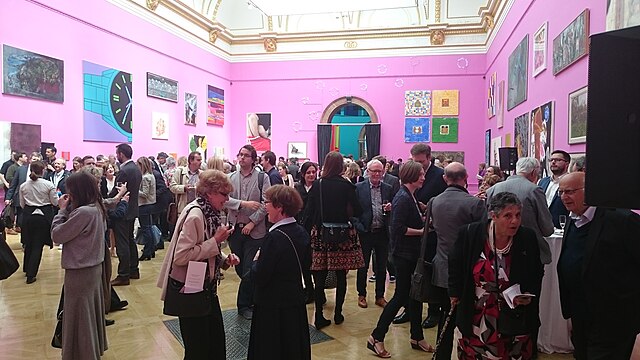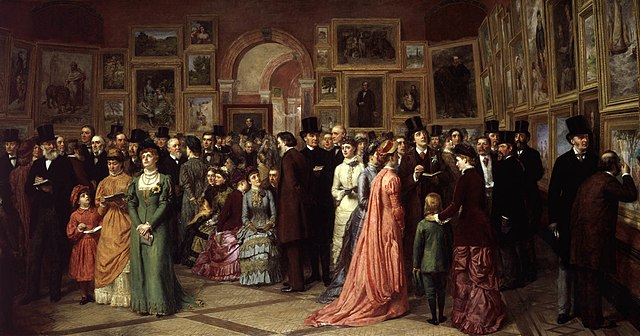Royal Academy Summer Exhibition
Annual open art exhibition in England From Wikipedia, the free encyclopedia
The Summer Exhibition is an open art exhibition held annually by the Royal Academy in Burlington House, Piccadilly in central London, England, during the months of June, July, and August. The exhibition includes paintings, prints, drawings, sculpture, architectural designs and models, and is the largest and most popular open exhibition in the United Kingdom.[1] It is also "the longest continuously staged exhibition of contemporary art in the world".[2]


When the Royal Academy was founded in 1768 one of its key objectives was to establish an annual exhibition, open to all artists of merit, which could be visited by the public. The first Summer Exhibition took place in 1769; it has been held every year since without exception.[1]
History

In 1768, a group of artists visited King George III and sought his permission to establish a society for Arts and Design. They proposed the idea of an annual exhibition and a school design. King George III approved of the idea and the first exhibition, in 1769, included 136 works.[2] The name Summer Exhibition dates from 1870.[2]
Selection process
Today, around 1,000 works are selected each year from as many as 32,000 entries representing some 16,000 artists.[citation needed] Any artist (living, known or unknown) may submit up to two works at a fee of £40 per piece for selection by The Summer Exhibition Selection and Hanging Committee.[citation needed] Due to the significant increase in the volume of entries over recent years, the number of entries per artist was reduced to 2 (from 3) and the fee was increased per piece. The committee is formed from the Council of Academicians (the governing body of the RA) and is traditionally chaired by the President of the Royal Academy. In addition to those works selected by the committee, all 80 Academicians are entitled to have six of their own pieces in the exhibition.
For the 2006 exhibition, the academy received a statue and a plinth from David Hensel. By mistake, the two parts were judged independently, with the result that the statue was rejected and the plinth put on display.[3] Some artists apply repeatedly before being selected: in 2024 Alison Aye's accepted piece Shifting to the Moon was her 31st submission.[4]
Exhibition
Summarize
Perspective

The RA Summer Exhibition usually opens to the public in early June, preceded by a series of private viewings. The main event is called "Varnishing Day", the day that, according to popular legend, artists would come to add a final coat of varnish to their paintings (compare: vernissage). Traditionally, artists walk in procession from Burlington House to St James's Church, Piccadilly, where a service is held. At the opening reception the shortlists for various prizes are announced.
Some years have particular themes. The 2005 exhibition theme was "Printmaking and the multiple". In 2006, the theme was "From Life." In 2008, the theme was "Man Made". The theme for 2010 was "Raw".[5] In 2011, the selection committee agreed to have no specific theme.[citation needed]
Almost all exhibited works are for sale; the Academy receives 30% of the purchase price. In 2003, this amounted to a sum of some £2,000,000 for the institution, which receives no financial support from the state or crown.[citation needed]
Coordinators
- 2005 Stephen Farthing and Christopher Orr[6]
- 2010 Stephen Chambers[7]
- 2011 Christopher Le Brun[8]
- 2012 Tess Jaray[9]
- 2013 Eva Jiřičná and Norman Ackroyd[10]
- 2014 Hughie O'Donoghue[11]
- 2015 Michael Craig-Martin[12]
- 2016 Yinka Shonibare[13]
- 2017 Eileen Cooper[14]
- 2018 Grayson Perry[15][16]
- 2019 Jock McFadyen[17]
- 2020 Jane and Louise Wilson[18]
- 2021 Yinka Shonibare[19]
- 2022 Alison Wilding[20]
- 2023 David Remfry[21]
- 2024 Ann Christopher[22]
Awards
Summarize
Perspective
Over £70,000 prize money, including the £25,000 Charles Wollaston Award, is awarded each year at the Summer Exhibition. In addition, a £10,000 architectural prize is awarded.[23]
Winners of Charles Wollaston Award
| Year | Artist | Artwork | Medium | Exhibited | View | Ref. |
|---|---|---|---|---|---|---|
| 1978 | Peter Greenham | Lady Bonham Carter | Oil on canvas | Gallery I | Tate | [24] |
| 1979 | Roger de Grey | Marennes | Oil on canvas | Gallery III | [25] | |
| 1980 | Anthony Gross | |||||
| 1981 | ||||||
| 1982 | Robert Buhler | |||||
| 1983 | ||||||
| 1984 | ||||||
| 1985 | ||||||
| 1986 | ||||||
| 1987 | John Bellany | |||||
| 1988 | ||||||
| 1989 | ||||||
| 1990 | ||||||
| 1991 | Neil Jeffries | [26] | ||||
| 1992 | Sandra Blow | Whisperings | Acrylic | Gallery III | [27] | |
| 1993 | ||||||
| 1994 | Robert Medley | Preparation for the Execution | Oil on canvas | Gallery II | Royal Academy | [28] |
| 1995 | Barry Flanagan | The Cricketer | Bronze | Courtyard | Jesus College, Cambridge | [29] |
| 1996 | Jeffery Camp | [30] | ||||
| 1997 | R. B. Kitaj | Sandra Three | Mixed media — view installation | Gallery II | Centrepiece at Astrup Fearnley Museet | |
| 1998 | John Hoyland | Tree Music 6.3.98 | Acrylic on cotton | Gallery VI | Private Collection | [31] |
| 1999 | David Hockney | A Bigger Grand Canyon | Oil on sixty canvases | Lecture Room | National Gallery of Australia | [32] |
| 2000 | Gerard Hemsworth | Between Heaven and Hell 1998 | Acrylic on canvas | Gallery IV | [33] | |
| 2001 | Marc Quinn | Catherine Long | Marble | Large Weston Room | [34] | |
| 2002 | Alan Charlton | Vertical Painting in 20 | Acrylic on canvas | Gallery IV | [35] | |
| 2003 | Jake and Dinos Chapman | Marriage of Reason and Squalor II | Painted Bronze | Gallery I | [36] | |
| 2004 | ||||||
| 2005 | ||||||
| 2006 | Chantal Joffe | Blond Girl - Black Dress | Oil on board | Gallery III | [37] | |
| 2007 | Gavin Turk | Dumb Candle | Wood | Gallery I | [38] | |
| 2008 | Jeff Koons | Cracked Egg (Blue) 1994-2006 | High chromium stainless steel with transparent colour coating | Central Hall | ||
| 2009 | Richard Wilson | |||||
| 2010 | Yinka Shonibare | Crash Willy | Mannequin, Dutch wax printed cotton textile, leather, fibreglass and metal | Wohl Central Hall | [39] | |
| 2011 | Alison Wilding | Take a Deep Breath… | Painted foam, copper and fibreglass resin | Lecture Room | [40] | |
| 2012 | Anselm Kiefer | Samson | Oil, acrylic, steel, pastel and charcoal | Large Weston Room | ||
| 2013 | El Anatsui | TSIATSIA – searching for connection | Aluminium (bottle tops, printing plates, roofing sheets) and copper wire | Courtyard
(facade of the RA) |
[41] | |
| 2014 | Wolfgang Tillmans | Greifbar 1 | Inkjet print | Gallery IX | [42] | |
| 2015 | Rose Wylie | Herr Rehlinger In White Armour | Oil on canvas | Gallery III | ||
| 2016 | David Nash | Big Black | Charred redwood | Gallery IV | ||
| 2017 | Isaac Julien | Western Union: Small Boats | Five screen projection | Gallery X | ||
| 2018 | Mike Nelson | Untitled (Public sculpture for a redundant space) | Sleeping bag, concrete and rubble | The Annenberg Courtyard & Staircase | Royal Academy | |
| 2019 | Joe Tilson | Finestra Venezia | Thirty-six Murano glass works for the Grande Albergo Ausonia and Hungaria | Gallery II | ||
| 2020 | ||||||
| 2021 | Naomi Gakunga | Wetereire – Waiting | Stainless steel wire, sheet metal and paper | Lecture Room | ||
| 2022 | Uta Kögelsberger | Cull | Video | Small Weston Room | ||
| 2023 | Kara Walker | The Omicron Variations | Ink on paper | Gallery III | [43] | |
| 2024 | Tracey Emin | Did it Ever Get Any Better | Acrylic on canvas | Gallery III |
Reception
The exhibition has received both admiration and criticism.[2] Jonathan Jones described it in 2019 as the "bloated corpse of a tradition ... [with] a tired, inward looking, end-of-the-road quality".[17]
An exhibition about the history of the Summer Exhibition, The Great Spectacle, was held in 2018.[44]
References
Further reading
External links
Wikiwand - on
Seamless Wikipedia browsing. On steroids.
